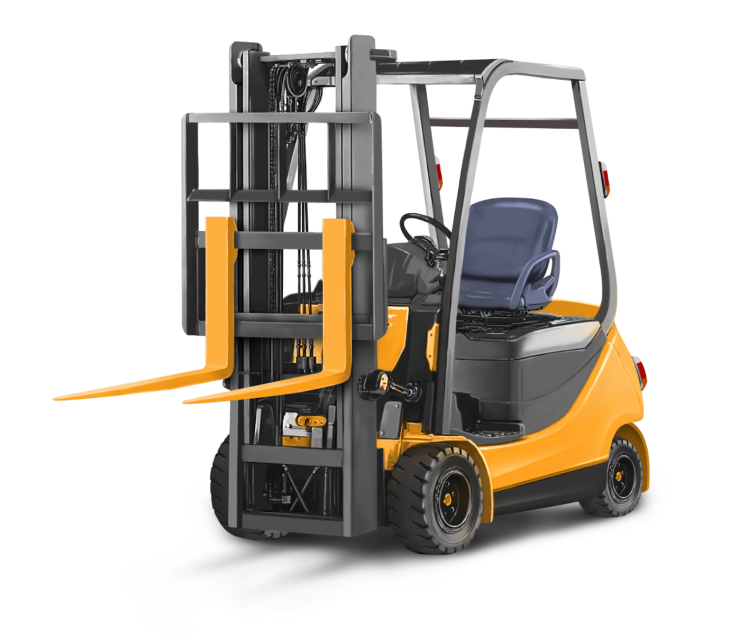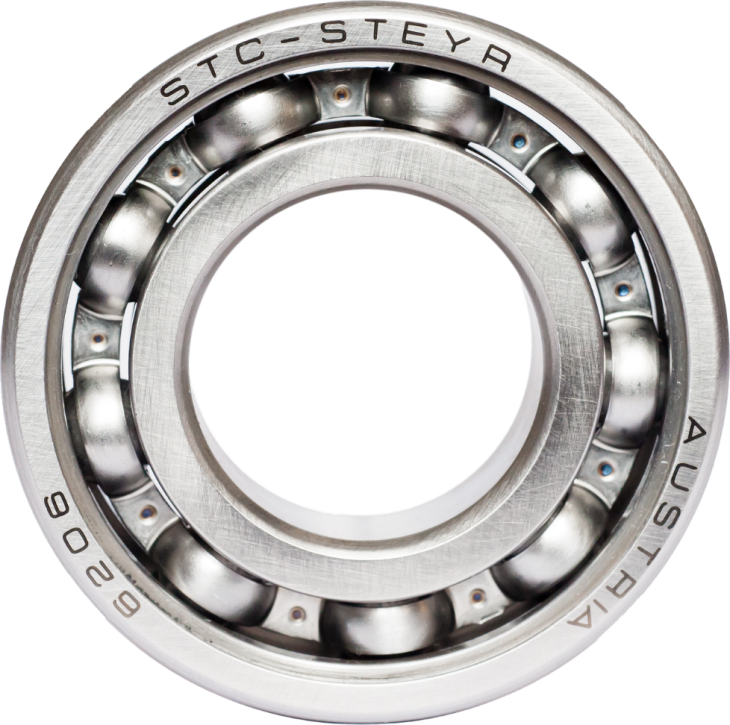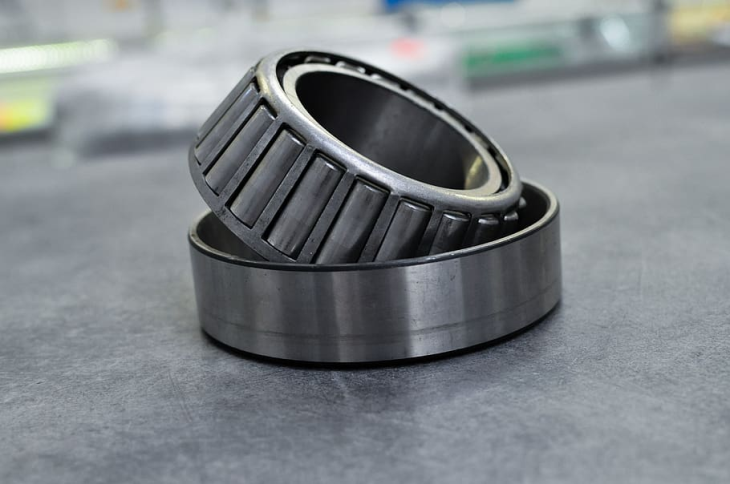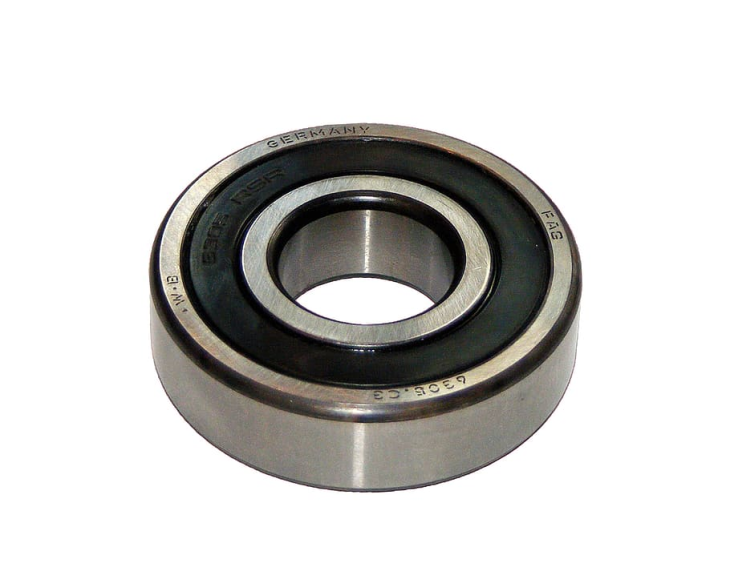Mast Guide Bearings Information
Mast guide bearings are used in high radial or thrust load applications operating at low speeds. They typically have a thick cross-section and are used as guide rollers. The outer ring is used as a wheel against a steel mast rail. Mast guide bearings have a thick outer ring to withstand higher loads.
These bearings are specifically designed to accommodate heavy radial loads, high shock loads, and overturning moments as a result of combined radial and thrust loads.
Applications
Figure 1: Photorealistic rendition of a forklift truck. Source: Compliance and Safety, LLC/CC BY-SA 3.0
This family of bearings is designed for specific applications. A common application for mast guide bearings is to guide the telescopic mast section in forklifts. The mast guide bearing allows for the smooth extension of the mast during each stage. This family of bearings is also used in cam drives conveying equipment, slide-ways, and other equipment.
Video: Forklift bearings in motion. Source: hsbearing
Mast guide bearings used in forklifts may come as a set with a carriage bearing that provides lateral guidance, side thrust rollers that help prevent twist, and chain roller bearings that guide the leaf chain used to increase or decrease the height of the mast. The bearings may be fitted as a complete assembly, which are called combined roller bearings.
Rolling Elements
Mast guide bearings can be designed with differently shaped rolling elements. Mast guide bearings are often chosen to manufacturer recommendations of the equipment. When replacing a mast guide bearing, typically these specifications are followed. When replacing mast guide bearings on a forklift, the make of the fork truck and the part numbers or brands on the bearing help identify the bearing and select an appropriate replacement. This depends on the inner diameter (ID), the outside diameter (OD), and the width of the outer ring (OR) and inner ring (IW), which are crucial in choosing the correct bearing.
Typically ball bearings are used with lighter loads and at higher speeds in comparison to roller bearings. Roller bearings are more aptly suited for shock and impact. Mast guide bearings can be designed with balls or rollers depending on the equipment.
Balls
Figure 2: Ball bearing. Source: Pixabay
Ball bearings use a number of spherical elements separated by a carrier. The ball bearing consists of inner and outer raceways. When installed, the inner raceways are often pressed against a shaft while the outer race is held inside housing. Ball bearings can be designed to handle radial loads, axial loads, or a combination of both axial and radial loads. The spheres make point contact with the race. The slight deformation of the balls is designed to not exceed the yield point of the bearing material.
Rollers
Figure 3: Tapered roller bearing. Source: Pxfuel
Roller bearings have line contact instead of point contact with the race, this allows them to be able to withstand greater loads and have more shock resistance. They are designed similarly to ball bearings.
Spherical roller bearings are well-suited to handle misalignment and shaft deflection. They can handle axial loads from either direction along with high shock loads. Cylindrical roller bearings are primarily designed for radial loads, these bearings have rollers that are longer than their diameter. Needle roller bearings have thinner rollers than conventional roller bearings. Some designs may have an inner ring while some do not. They are an ideal choice in situations with radial space constraints that require heavy load and high-speed resistances. Taper roller bearing support both thrust and radial loads. However, this style of roller can only handle axial loads from one direction. A second laterally reversed bearing is required in applications to provide counterstay.
Seals/Shielding
To help retain lubrication and protect the bearing from external environmental conditions, the bearings are typically sealed. Mast guide bearings are often sealed with metal or rubber/synthetic material, to protect against contaminants. They can be sealed with a combination of the two as well. Bearing code suffixes identify the type of seal the bearing has.
- 2 RS — Double rubber/synthetic seal
- RS — Single rubber/synthetic seal
- 2Z or ZZ — Double metal shield
- Z — Metal shield on one side and open on another
Shield
Shielded bearings have metal enclosures instead of rubber or synthetic sealing. Shields are fastened to the outer ring and rotate together with the bearing. Metallic shields do not provide total enclosure of the bearings as there is a slight amount of clearance between the shield and inner ring. Impact can push the shield against the cage or the bearing rollers and balls.
Relubrication is not possible with double shielded bearings but single shielded bearings do need to be regreased. Double shielded bearings are often “lubricated for life.” The shield helps retain lubricant in the roller elements and prevents large contaminants from coming in contact with the rolling elements. Friction losses are lower than sealed bearings.
Seal
Figure 4: Bearing with a double seal. Source: Wallpaper Flare
The seal can be made from synthetic rubber or polypropylene. Single seals in bearings have two faces. Double seals in bearings have four faces. The faces are divided into rotating and stationary.
Double seals have greater friction losses than double shielded bearings. These types of bearings perform well in highly contaminated environments. They are more commonly used in lower speed applications and are “lubricated for life.”
Configurations
Mast guide bearings can come in a variety of configurations that have advantages in certain applications. The profile of the existing mast guide bearing can be assessed to choose the correct replacement.
Single Row
Single row bearings are often used in applications with lower radial and axial loads. This configuration has only a single row of balls or rollers.
Double Row
In double row bearings, there are two rows of balls or rollers. This type of bearing is often used where higher loads are expected or if high reliability is desired.
Outer Ring
The outer ring is used to guide the carriage in the mast channels. The outer ring is also known as the race. Mast guide bearings have thicker outer rings to withstand greater forces due to the application requirements.
The outer ring in mast guide bearings acts as guides and rollers for the carriage. The outer ring helps prevent misalignment when the mast’s height is increased or decreased.
Flat
Flat outer rings are a basic outer ring design.
Taper
Tapered bearings are designed to reduce friction, which as a result reduces the amount of heat generated during operation. The load can be transferred evenly while in use.
Single rowed tapered bearings are often adjusted with a second tapered roller bearing to create a rigid bearing application. Many tapered bearings are separable and components can be maintained or replaced individually. Tapered roller bearings do not tolerate misalignment well while spherical roller bearings fare better. They are well suited for lower speed applications.
Chamfer
Chamfering removes burrs caused by machining on parts. Chamfered bearings have angled or beveled corners.
Corner Radius
Outer rings with a corner radius have rounded corners. Corner radii minimize stress concentration and soften sharp edges. This creates a gradual transition between two perpendicular surfaces.
Flanges
Flange bearings have a cylindrical body and a flange at one end, this allows them to support radial loads and light axial loads as the flange provides a thrust surface. Flanges contribute to aligning and mounting the bearing when it is installed. The flange helps lock the bearing in place. Flange bearings are typically used in applications where there are a lot of vibrations. Double flange bearings are less common but have a flange on either end of the bearing.




